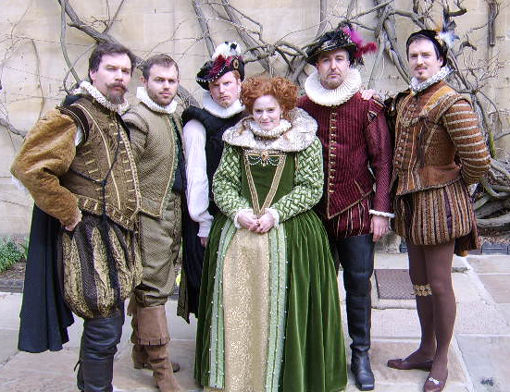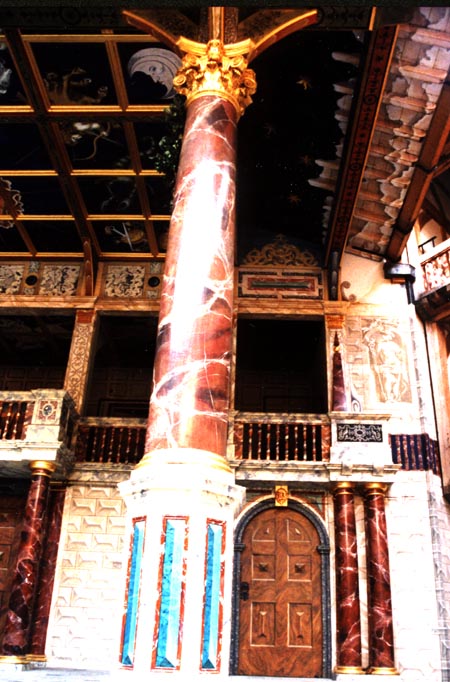Understanding The Language:
Information about words Shakespeare invented found here: http://mentalfloss.com/article/48657/20-words-we-owe-william-shakespeare
Understanding Shakespearian English wasn't any trouble at all for audience's in the Elizabethan Era. Each person in those days would have spoken just the same as the actors on stage. Looking at the fact that Actors didn't have long to learn their lines for Shakespeare's plays (3-5 days max!), they would have had to know what each word in the script means, saying them as well in the right tone and general delivery. Although it was easy for the audience, there were times where Shakespeare had invented his own language with words such as:
- Addiction - First used in the play called 'Othello' by way of this quote: “It is Othello's pleasure, our noble and valiant general, that, upon certain tidings now arrived, importing the mere perdition of the Turkish fleet, every man put himself into triumph; some to dance, some to make bonfires, each man to what sport and revels his addiction leads him.” – Herald, Act 2 Scene 2
- Assassination - First used in the play called 'Macbeth' by way of this quote: “If it were done when 'tis done, then 'twere well it were done quickly: if the assassination could trammel up the consequence, and catch with his surcease success.” – Macbeth, Act 1 Scene 7
- Bedazzled - First used in the play called 'The Taming of the Shrew' by way of this quote: “Pardon, old father, my mistaking eyes, that have been so bedazzled with the sun that everything I look on seemeth green.” – Katherina, Act 4 Scene 5
Which Character(s) Would Audience Members Relate To The Most?:
To start this section off, I want to talk about the more relatable characters of 'Much Ado About Nothing': Beatrice, Benedick, and Dogberry with his crew.
I believe the main reason why this play is so much more popular than most other Shakespeare plays is because of all the witty banter the audience, both Elizabethan and Modern, amuse themselves watching. Scenes such as Act 1 Scene 1 in the play, where we witness Beatrice and Benedick having a conversation filled with banter throughout. The audience would participate in this event, by siding with their gender against the other, a witty battle between man and woman to see who comes out on top.
Dogberry, as well as his crew, would also be popular and relatable with audience members because of his unintended humorous moments where he would, for example, say a line such as "Aspicious" when he was meant to say "Suspicious". Because of their lower status in society, yet the play uses quite formal words throughout, it's a funny and comedic moment to have for a character that can't use certain words properly. I have a clip in one of my earlier entries and I talk about this more there.
When watching the adaptation of 'Much Ado About Nothing' staring Catherine Tate and David Tennant, I couldn't wait for these 3 particular characters to come on stage. Not because they're famous, worldwide actors, but because they portray them so well. I loved the moments of banter between Beatrice and Benedick, there were some moments that looked quite awkward for the two, yet the actors retained that moment whilst the audience would laugh at them.
How Much Different Audience Members Would React To Certain Scenes:
There are scenes in the play where the actor would pause slightly between lines. This can be a stage method of making the audience laugh if they get what the character is talking about or just to make the monologue flow with efficiency. Here is one scene in-particular that I quite like featuring Benedick performing his monologue in Act 2 Scene 1 at the party: https://www.youtube.com/watch?v=UNIQm7vEa2o&index=5&list=PLVKiCaVA-ouRLmb_UIla3rDGfUg6FrexS
Now this moment in the play is quite interesting when I start to think about this play being performed in Elizabethan times. The actor on stage in those days would have had to rush through the monologue otherwise the audience would get bored and just think the actor had forgotten his line if he did pause like David Tennant did in that clip. But because of how well he can pull it off, and how much more patient modern audiences have become, David Tennant had the ability to pull off things such as these pauses for his scene. Doing this as well as doing other amusing things such as facial expression, slight change of tone in his voice does also make you laugh. Actors in Elizabethan times, I think, may have been more blank faced in a way. They didn't have long to learn their lines each week for each performance, and I think the expressions would have came for later performances or maybe never at all.
There is also another scene that would have been taken into a different perspective from audience members, both Elizabethan and Modern: Act 4 Scene 1. In this scene, Claudio and Hero are about to married, events transpire, and then Hero faints with Claudio, Don Pedro, and Don John exiting the scene. After the characters left on stage talk for a little bit, the friar says this line:
"Pause awhile, and let my counsel sway you in this case. Your daughter here the princes left for dead; Let her awhile be secretly kept in, and publish it that she is dead indeed. Maintain a mourning ostentation, and on your family's old monument Hang mournful epitaphs and do all rites that appertain unto a burial."
After saying this line, the Friar performs quite a long piece of text which pretty much says that after he fakes Hero's death, the friar taunts Claudio implying that Claudio's words contributed, or maybe even caused, Hero to commit suicide, leaving Claudio feeling guilt and remorse for what he said.
After watching this scene, I felt as though I was emotionally affected for Claudio and the trauma and suffering he was going through after being told he was responsible for the love of his life's death and then to eventually find out that she was not dead at all.
It would be much different for a Shakespearian audience when compared to the modern as we have become desensitised to distress, heartbreak, trauma, suffering, pain, death, murder with the invention of electronic media in all of its forms. Examples include games, television, films/cinema. Younger people see these things and they do become desensitised because of it. Younger people would play violent games watching death and destruction happen all around them. And then, as they grow up, it lessens the impact on their behaviours towards death and destruction. When a disaster happens in the Modern Era, we are inundated with information surrounding the incident, which is transmitted to every conceivable electronic form of media and again in print form in term of newspapers. Shakespeare's audience would have less experience of this. They may have had little to no news of events occurring in the world, and anything that did happen, depending on where it did happen and the severity of it, it could take days to weeks to arrive elsewhere by form of a carrier pigeon or someone simply passing the message along.
Men Playing As Women!:
Of course, there is another thing about Shakespearian theatre. There is the fact that the roles of woman were played by men. During the Elizabethan Era, it was illegal for a woman to be performing on stage. Examples of this happening still occur today in many situations, and some of them don't have anything to do with performance. Take, for example, young woman with masculine features dressing up and doing things as boys. They do things this way for any sort of reason, they may not like their sexuality, they may be avoiding to be punished for their sexuality, it can also be a way of deceiving others. Things such as this happen in many modern productions such as 'She's the Man' (2006), Just One of the Guys (1985), and the Disney classic Mulan (1998).
Obviously, in modern adaptations of 'Much Ado About Nothing', we now have women playing women. It's a much more accepted picture to see both Men and Women on stage at the same time. I wouldn't have found it very interesting to see a man portraying a woman, unless it's a pantomime, during the Elizabethan Era. Certain Actors in those times got quite famous for their roles of playing women, but after the laws changed, those actors were out of a job. Fortunately in todays world, actors who mainly portray women can easily got another job, such as pantomimes, which happen quite often in theatres all around the world.
Table Of Comparison Between Original And Modern Version:
To finish this final entry on this assignment, I'd like to demonstrate evidence on my analysis of how the play 'Much Ado About Nothing' has been modernised for contemporary audience's but still follows the guidelines of the original script:
Elizabethan Times Original
Adaptation
|
David Tennant and Catherine
Tate Adaptation
|
Set in Elizabethan Times
(1500’s)
|
Set in the 1980’s
|
Royalists, the men in the
play were the prince’s guards.
|
Most of the men in the play
were in the navy.
|
The weapons used within this
age would have been swords, knives, pretty much anything that could be used
as a weapon.
|
The weapons used within this
modern adaptation would have included weapons such as guns, knives and also
ceremonial swords as evidenced by the wedding scene where Benedick is holding a sword on his left
side.
|
All of the Women in the play
would have been played by Men as, during this age, it was considered illegal for
Women to perform in any kind on stage.
|
As the modern era is a lot
less sexist, Women are allowed to play Women in performances.
|
The play is set in Messina,
possibly on the grounds of Leonarto’s Estate.
|
This adaptation is set in Gibraltar.
I’m not quite sure on the specific location, but the whole play seems to take
place within a fancy building that can hold weddings, fancy dress parties and
hold special ‘Knights of the Watch’ meetings.
|
The transport used would have
been horse and carriage, or some sort of vehicle that’s able to bring
Benedick on stage.
|
In this adaptation, Benedick
arrives in his first scene driving a golf cart.
|
For any music within the
play, in this age they would have used a mixture of singers or instruments
that would have been invented at that time.
|
Within the play, there are
scenes that contain things such as Radio’s, Cassette tapes and a mini
electric keyboard.
|
They would have done a masked
ball for the original performance.
|
For this adaptation, they had
a fancy dress party where the characters dressed up as whoever they wished.
For example, Catherine Tate I believe was trying to mimic one of Michael
Jackson’s costumes from a music video, whereas Benedick was trying to look
like a female hooker of some kind.
|
The language used within this
time would have been Elizabethan English. An example would be Beatrice saying
the word “Nay…” during a scene.
|
The language used within this
modern adaptation would be along the lines the same, but some words have a
modern tone and dialect. Catherine Tate brings her famous and most
recognisable line “No…” instead of the original “Nay…”
|









